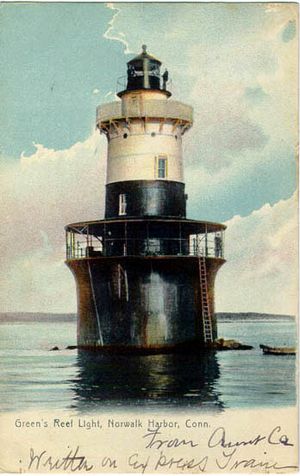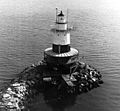Greens Ledge Light facts for kids
 |
|
| The light in a 1907 postcard | |
|
|
|
| Location | Norwalk Darien Connecticut United States |
|---|---|
| Coordinates | 41°2′30″N 73°26′38.2″W / 41.04167°N 73.443944°W |
| Year first constructed | 1902 |
| Automated | 1972 |
| Foundation | cast iron with concrete caisson |
| Construction | Sparkplug lighthouse |
| Tower shape | 2-stages cylindrical tower with double balcony and lantern incorporating keeper's quarter |
| Markings / pattern | white upper half, brown on black lower half, black basement |
| Height | 52 feet (16 m) |
| Focal height | 62 feet (19 m) |
| Original lens | 5th order Fresnel lens (replaced with a 4th order) |
| Current lens | VRB-25 |
| Range | white: 18 nautical miles (33 km; 21 mi) red: 15 nautical miles (28 km; 17 mi) |
| Characteristic | Al WR 12s. |
| Fog signal | 2 blasts every 20s. |
| Admiralty number | J0866 |
| ARLHS number | USA-355 |
| USCG number | 1-21340 |
The Greens Ledge Light is an old and important lighthouse. It is located in the western part of Long Island Sound. You can find it near Norwalk, Connecticut and Darien, Connecticut. This lighthouse is special because it's one of only 33 "sparkplug lighthouses" left in the United States. It still works today, helping boats find their way safely.
The lighthouse sits on a shallow underwater reef called Greens Ledge. This reef is about a mile west of Sheffield Island. It's also about a mile south of the entrance to Five Mile River at Rowayton. The lighthouse was finished in 1902 by the Philadelphia Construction Company. It's made of cast-iron and stands about 90 feet tall. This includes about 15 feet of its base that is underwater.
In 1933, many tons of rocks were added around the lighthouse's base. These rocks came from the digging done for Radio City Music Hall in New York City. The Greens Ledge Light was added to the National Register of Historic Places on May 29, 1990. This means it's recognized as an important historical building.
In 2017, a group of local people formed a non-profit organization. It's called the Greens Ledge Light Preservation Society. They bought the lighthouse from the U.S. Government. Their goal is to fix and protect the lighthouse. Work to restore the lighthouse began in June 2018.
Contents
Building the Lighthouse
In the 1890s, people first suggested building a lighthouse here. It was meant to guide ships into Norwalk Harbor. In 1899, the United States Congress agreed to give $60,000 for the lighthouse. This money would pay for the light and a fog signal.
In 1900, the Philadelphia Construction Company was hired. They built the base and the main structure of the lighthouse. The idea for this type of lighthouse, called a sparkplug lighthouse, came from Major Eliiot in 1873. He worked for the United States Lighthouse Board.
The base of the lighthouse is made of strong, curved iron plates. These plates are bolted together to form rings. The rings are then lowered into the water. Workers filled them with concrete to make a very strong foundation. Pictures from 1901 show how the parts were put together. They also show the lighthouse cylinder being lowered into the water. Rocks were later added around the base to protect it.
What is a Sparkplug Lighthouse?
The Greens Ledge Light is a great example of a sparkplug lighthouse. These lighthouses look a bit like a sparkplug. They are tall, cylindrical towers built on a strong, wide base. This design helps them stand firm in the water.
The Greens Ledge Light is 52 feet tall. It stands in 10 feet of water. The base of the lighthouse widens out to support the main building. Inside the base, there's a brick basement and tanks for water. The lighthouse itself has four stories. It's made from five layers of curved iron plates. The inside walls are lined with brick. This helps keep the lighthouse warm and makes it stronger. It also provides a place for the winding cast-iron stairs.
The lighthouse has a deck that goes around it above the first floor. There's also a watchroom and a lantern room at the top. The main door faces south. The first floor was used as a kitchen. The second floor had two rooms, one of which was a bathroom. The fourth floor has six round windows, like portholes on a ship. The lantern room at the very top is 7 feet wide. When the Greens Ledge Light started working, the nearby Sheffield Island Light was no longer needed.
How the Light Works
When it first started, the lighthouse had a special lens called a fifth-order Fresnel lens. But just three months later, in May 1902, a stronger fourth-order Fresnel lens was put in. The light used to be a steady white light with a red flash every 15 seconds.
In 1972, the lighthouse became automated. This means keepers no longer had to live there. The old Fresnel lens was replaced with a modern light. The lighthouse still works today, guiding ships. In 1987, a new light called a FA-251 was installed. Later, the current lens, a VRB-25, was put in.
Now, the light flashes white and red, alternating every 24 seconds. The white flash can be seen from 18 nautical miles away. The red flash can be seen from 15 nautical miles away.
Over time, the lighthouse tower started to lean a little. The keepers even moved furniture to one side to balance it! This leaning problem got worse after a big storm in 1938 called the 1938 New England hurricane.
Why This Lighthouse is Important
The Greens Ledge Lighthouse was added to the National Register of Historic Places on May 29, 1990. It's important because it's a great example of a "pre-fabricated cast-iron conical lighttower." This means it was built from parts made in a factory and then put together on site.
The lighthouse has also inspired people. An artist named Walter DuBois Richards painted it for over 40 years. Since 1935, there's been an annual swimming race. It's called the Arthur J. Ladrigan Swim Race. Swimmers race one mile (1.6 km) from the lighthouse to Bayley Beach in Rowayton.
Lighthouse Keepers
Many brave people worked as keepers at Greens Ledge Light. They lived in the lighthouse and made sure the light kept shining. Here is a list of some of the known keepers:
| Name | Year |
|---|---|
| William DeLuce | 1902–1908 |
| Robert Burke | 1908–1909 |
| John Huskey | circa 1909 |
| John Kiarskon | circa 1910 |
| William T. Locke | 1910–1912 |
| William Rhodes | circa 1917 |
| George Petzolt | 1930–1932 |
| George Clark | 1939–1943 |
The Lighthouse is Sold
In September 2016, the Greens Ledge Light was put up for auction. It was sold on September 15, 2016, for $150,000. The Pettee Family bought it. They were the highest of four bidders.
The Pettee Family then gave the lighthouse to a new non-profit group. This group is called The Greens Ledge Light Preservation Society. They are now in charge of fixing and taking care of the lighthouse for the future.
Images for kids





